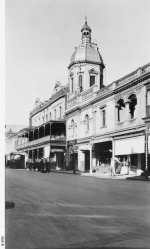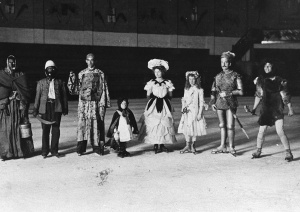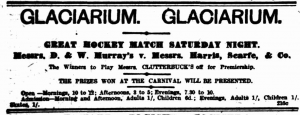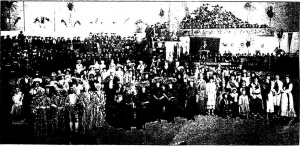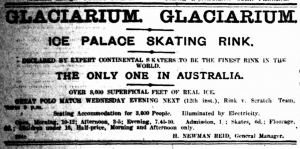Adelaide Glaciarium
The Adelaide Glaciarium (also known as Ice Palace Skating Rink) was the first indoor ice skating facility built in Australia. This is the birthplace for ice skating in Australia and is the location of the first hockey on the ice match in the country, which was an adaptation of roller polo for the ice using ice skates. Contemporary ice hockey was never played at this venue but this ice skating rink, the country's first, provided the "test bed" facility for its successor the Melbourne Glaciarium, the birthplace of ice hockey in Australia.
History
The Cyclorama buildings were built on Town Acre 74 in Adelaide, South Australia. This town acre was originally purchased by English born John Barton Hack, who was an early settler in Adelaide, at the beginning of the first land sales in Adelaide in March 1837 as part of a 60-acre lot purchase.[1] On the eastern half of the Town Acre 74 property the proprietor, Mr. William McLean, built the Grand Coffee Palace in 1890. Immediately to the west of the Grand Coffee Palace, he erected the Cyclorama Entrance tower and vestibule on the western half of Town Acre 74 in the same year and the tower entrance and vestibule wall adjoined the Grand Coffee Palace walls. The adjoining wall of the octagonal-walled viewing gallery encroached on the boundary of the half acre the Grand Coffee Palace was built on by enough to see the property boundary line 2 inches inside the adjoining wall of the viewing room. The eaves of the dome surpassed the boundary by 30 inches. The eastern walls of the tower and vestibule were supported by the west walls of the Grand Coffee Palace building. This was later not found to be an issue after a Civil Court case due to Mr. William McLean having been the owner of both town acres at the time the buildings were erected.[2]
The architects for the Cyclorama buildings were English & Soward, a business that started in 1880 consisting of Norwood, Adelaide born George Klewitz Soward and England born Australian migrant Thomas English. The cost of the project was £5000.[3]
Cyclorama
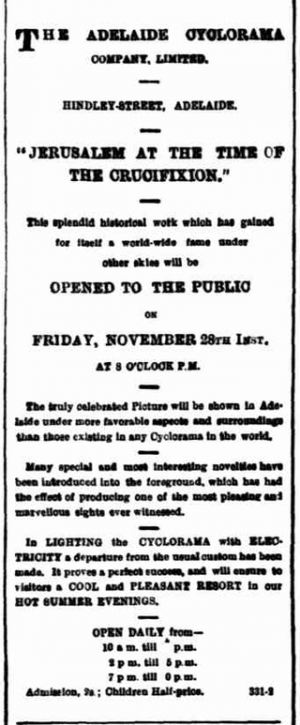
National Library of Australia[4]
The original buildings were located at 89 Hindley Street, Adelaide, South Australia and opened to the public as a Cyclorama at 8:00pm on Friday 28 November 1890.[5] The building was also referred to as the Trocadero even though it was more widely known as the Cyclorama.[6]
Architecture and specifications
The Cyclorama consisted of a street facing 2 storey Victorian terrace building with high Victorian dome, a long vestibule connecting the street facing tower to the main building, and the main building at the rear which housed the Cyclorama in a 'battle axe' style property.[2]
Tower Entrance – This was a 14-foot double storey Victorian terrace with high Victorian dome that faced Hindley Street. Patrons would enter the Cyclorama through the large wrought iron gate entry in the domed tower.[7] The tower rose to the height of 22.86 meters (75 feet)[8] and the dome itself was just over 3 meters (10 feet) in diameter. The room under the dome was used for patrons as a viewing gallery where a camera obscura would display a reflection of the surrounding country on the inside wall.[3] The room on top of the terrace was an octagonal construction.[2]
Vestibule – This long entrance hallway was a 28.96 meter (95 feet) long and 4.27 meter (14 feet) wide passage that connected the tower entrance building on Hindley Street and ran south to the large Cyclorama building at the rear of the property.[7] It contained 2 arched recesses on the wall adjoining the Grand Coffee Palace which was a 'party wall'.[2] The floor of the vestibule was asphalt and the hallway was well lit with electrical lighting. There were waiting rooms for ladies and gentlemen lining the hallway.[3]
Main building – The building itself was of brick construction and was 39.62 meters (130 feet) by 35.05 meters (115 feet) with large walls 14.33 meters (47 feet) high[9] The building itself was 39.62 meters (130 feet) by 35.05 meters (115 feet) and 14.33 meters (47 feet) in height and the plan was an ice floor surface of 35.05 meters (155 feet) by 25.6 meters (84 feet) was possible after an orchestra stand, platform and seating for 580 guests inside.[9] and only a single point of entry via a long vestibule. The roof was a single span timber construction and was half covered in glass panels, to let natural light in during the day, and half iron sheet. The building had incandescent lighting for the evening viewing sessions[8] The interior of the building originally had an elevated platform at its center with spiral stairs winding around it to give access to the top viewing platform, from where visitors would view the cycloramas being exhibited. In December 1898, two additional stages were added and the famous canvas painting of the Battle of Waterloo during extensive alteration work.[6]
Pricing and viewing times
The Cyclorama was open daily at the following times:[8]
- 10:00am to 5:00pm
- 7:00pm to 10:00pm
Lectures were held at the following times:[10]
- 11:30am
- 3:00pm
- 8:00pm
General Admission prices were:[10]
- Adults – 9 Shillings
- Children 1 Shilling
The exhibitions
The first exhibit the Adelaide Cyclorama Company Ltd showed at the Cyclorama was a picture of Jerusalem called Jerusalem at the Time of the Crucifixion.[8]
This image of Jerusalem was the subject of an allegation of copyright infringement by Fishburn Bros. of South Shields England, assignees of a German firm. The action began on Wednesday 9 March 1892 when it was brought before the Fall Court of Judges, seeking an injunction that restrained the Adelaide Cyclorama Group from using the picture and in the alternative claim be awarded £10,000 in damages. The claim was that the Jerusalem exhibition in the Adelaide Cyclorama was a copy of the panoramic painting by Bruno Piglhein depicting the crucifixion of Jesus Christ.[11]
The Trocadero Fire
On Saturday 11 March 1899 at approximately 2:40am the Adelaide Cyclorama was found to be on fire by Police Constable John Sweeny who was on duty patrolling Currie Street East and noticed a fire coming from the Cyclorama building. He ran down to Hindley Street where he saw that the fire had taken good hold of the building and immediately told another on duty officer Constable Deacon to get the fire brigade to the building, who received this call at 2:44am.[12] Passing by on his bicycle was Detective Jones, who rode to the fire alarm located on Hindley Streetand smashed the glass to sound it.[7] The fire reportedly had a strong hold on the building though the account was made that it was remarkable that the flames did not reach greater height considering the interior was inflammable, likely due to the lack of wind that morning.[13] Following instructing Constable Deacon to summon the fire brigade, Constable John Sweeny ran to Rosina Street and Solomon Street to wake people and alert them to the fire. He then headed back to the Cyclorama where he met Caretaker Mr. Hugentobler and Mrs. G. Gould at the gate entry as the partially dressed pair were exiting the Cyclorama building, unaware of the building being on fire and only coming out to see what the commotion was about – only being aroused by Constable John Sweeny's loud call of "Fire!".[12] The fire finally burned out at 4:00am and the Trocodero was a smoldering ruin.[6]
The Manager of the Adelaide branch of the Commercial Bank, Edward Jones, said the Cyclorama building was insured for £2,000, the engine and electric light plant was insured for £125. The panoramas inside the building were the picture of Waterloo that was insured for £500 and the picture of the Crimea War which was insured for £300.[12] Both panoramas were lost to the fire that completely destroyed the building.[6]
Glaciarium
On Wednesday 1 June 1904 the prospectus for the acquisition of the Cyclorama building on 89 Hindley Street, Adelaide was issued.[9] The following day in an interview, H. Newman Reid discussed the dimensions of the building, internal layout, seating capacity and ice surface dimensions and how the present Cyclorama building is well adapted for the purposes of the proposed Glaciariam project.[9] The building itself was 39.62 meters (130 feet) by 35.05 meters (115 feet) and 14.33 meters (47 feet) in height and the plan was an ice floor surface of 35.05 meters (155 feet) by 25.6 meters (84 feet) was possible after an orchestra stand, platform and seating for 580 guests inside.[9]
The remodeled Cyclorama building opened as the Glaciarium on the evening of Tuesday 6 September 1904.[14]
A common newspaper to find regular advertisements for events was The Advertiser. Advertisements would always be under the "Amusements" section, as would game and event reports. The "Amusements" section was shared with the Theatre Royal, art exhibitions and the roller skating rink, who had very similar events to the Glaciarium such as fancy dress carnivals. The regularly-played hockey on the ice matches were never placed in the "Sports" section of this newspaper.
After closing down for the summer season, the Glaciarium re opened on 2 March 1905, featuring a skating exhibition by Professor Brewer.[15]
The 1905 ice skating season closed down for the summer on 14 October 1905.[16]
Pricing and session times
There were 3 sessions available during the day:[18]
- Morning Session 10:00am to 12:00noon
- Afternoon Session 3:00pm to 5:00pm
- Evening Session 7:30pm to 10:00pm
Pricing for sessions depended on time of day:[18]
- Morning Session: Adults 1 shilling, Children 6 pence
- Afternoon Session: Adults 1 Shilling, Children 6 pence
- Evening Session: Adults 1 Shilling, Children 1 Shilling
Ice skate hire was available:[18]
- Skates: 1 shilling
Types of events held
Among the skating sessions there was a variety of events held at the Glaciarium. On 21 July 1905, basketball on ice was tried for the first time in front of the laughter of a crowd.[20]
Carnivals
Fancy Dress carnivals were held often and attracted many people, awards were held for a variety of categories such as Best Costume, Most Original Costume, Best Poster Costume, Most Sustained Character and Most Grotesque Costume.
Skating
Very regularly, exhibitions of various forms of skating were held by Professor James Brewer, such as fast skating, international skating and fancy skating.
Sporting events were held at the carnivals in the following categories:
- Quarter-mile Hurdle Race
- Half-mile Scratch Race
Hockey on the ice
"Hockey on the ice", in the early 1900s in Adelaide was a term used to describe the popular sport of roller polo having been adapted to an ice surface and using ice skates, also known elsewhere around the world as "ice polo". Each team had 6 players. In the 10 October 1904 edition of The Advertiser, the first match to be played at the month old Adelaide Glaciarium was advertised for the first time as a polo match.[22] The following day, it was advertised as a hockey match and the term continued to be used from that point onward.[23]
The First Game
The first match for this adapted form of roller polo, hockey on the ice, was played during a carnival in the Glaciarium at 9:00pm on 12 October 1904. A match was organised between a Rink team and a Scratch team, picked from the visitors to the rink. It was described by a reporter as being like football on ice skates. The match itself was part of a range of sports and carnival activities for the evening where those attending were dressed in costume and fancy dress.[24]
The game was played in 4 quarters and Dr. Harrold scored 2 goals for the Scratch Team in the first quarter. In the last quarter the Rink team scored 2 goals to tie up the game and the game ended in a 2-2 draw.[25]
The Teams were as follows:[25]
Rink
- Watts
- Langley
- Bates
- Barnett
- Professor Caldwell (captain)
Scratch Team
- Rev. A. N. Garrett
- Dr. R. E. Harrold[26]
- Rhoeder
- F. Gate
- J. Gow (captain)
Early Matches
Hockey on the ice is a term used for the stick and ball game played on an ice surface and the use of the phrase can be traced back to at least 1853 to describe a game played at Windsor Castle in England. The earliest known record of a Bandy club in England is from 1813 by the name of Bury Fen Bandy Club, who were responsible for the creation of the majority of the rules when bandy was later codified in 1882. The rules of bandy have many similarities to the rules in the sport of football (soccer).[27] Before bandy was codified, ice hockey first had its rules published on 27 February 1877 in the Montreal newspaper, The Gazette. It was likened to field hockey and even continued to use the word ball within the set of rules.[28] Ice hockey would spread across Canada and the northern part of the United States of America but bandy would spread across Northern European countries.[27] What was being called hockey on the ice in the Adelaide Glaciarium was played while skating on the ice and hitting a sphere with a hooked roller polo stick, while on ice skates.[29] The score for each team involved a tally of both goals and points and was an adaptation of the already popular activity of roller polo, on ice.
The first hockey on the ice match between employees representing local businesses was on 15 May 1905. The match was between G. & R. Wills & Co. and D. & W. Murray, Limited which was assembled from a group of novices.[30]
Early hockey on the ice match dates and results
| Rink vs Scratch/Adelaide Team Hockey on the Ice Games | ||||||
|---|---|---|---|---|---|---|
| Date | Team 1 | Goals | Points | Team 2 | Goals | Points |
| 12 October 1904[31] | Rink | 2 | 0 | Scratch Team | 2 | 0 |
| 15 October 1904[32] | Rink | N/A | N/A | Scratch Team | N/A | N/A |
| 22 March 1905[33] | Rink | N/A | N/A | Adelaide Team | N/A | N/A |
| 29 March 1905[34] | Rink | N/A | N/A | Adelaide Team | N/A | N/A |
| 17 April 1905[35] | Rink | N/A | N/A | Adelaide Team | N/A | N/A |
| 28 April 1905[36] | North Adelaide Team | 1 | 0 | South Adelaide Team | 2 | 0 |
| 1 May 1905[37] | North Adelaide Team | N/A | N/A | South Adelaide Team | N/A | N/A |
| 15 May 1905[38] | G. & R Wills & Co. | N/A | N/A | D. & W. Murray, Limited | N/A | N/A |
Warehouseman's Association
On Wednesday 24 May 1905, the first match of the series of matches held under the auspices Warehouseman's Association was played between a team representing G. & R. Wills & Co. and a team representing James Marshall & Co. This game was played in front of 800 people.[39] The first announcement of this Association was on 19 May 1905.[40] The teams playing under the endorsement Warehouseman's Association were groups of men (Messrs.) who were employees of the following local companies:[24]
- G. & R. Wills & Co.
- James Marshall & Co.
- Harris, Scarfe & Co.
- Clutterbuck Brothers
- D. & W. Murray, Limited
- Elder, Smith & Co.
- Goode, Durrant & Co.[41]
On Wednesday 5 July 1905, teams representing Australia and England played a Hockey on the Ice match at the Adelaide Glaciarium. The players on each team were as follows:[42]
Australia – Parker, Clutterbuck, Hosking, Nightingale, Butler, Part
England – Swanson, Barker, Poole, Knight, Watts, Osendale
In the evening of 5 August 1905, the teams D&W Murray's would play a match of hockey on the ice against team Harris, Scarfe & Co as part of the Warehouseman's Hockey Association. The winning team of the match would play the Clutterbucks for the premiership and gold medal.[18] Professor James Brewer, billed as "The World's Greatest Skater", would appear on the same night in the fancy skating.
The results of the Premiership match, held 12 August 1905, saw Harris, Scarfe & Co win by a goal.[43]
Warehouseman's Association hockey on the ice dates and results
| Warehouseman's Association Hockey on the Ice Games in 1905 | |||||||
|---|---|---|---|---|---|---|---|
| Date | Team 1 | Goals | Points | Team 2 | Goals | Points | |
| 24 May 1905[39] | G. & R. Wills & Co. | 2 | 5 | James Marshall & Co. | 1 | 3 | |
| 26 May 1905[44] | D. & W. Murray, Limited | 2 | 4 | Goode, Durrant & Co. | 0 | 1 | |
| 2 June 1905[45] | D. & W. Murray, Limited | 7 | 1 | James Marshall & Co. | 1 | 3 | |
| 9 June 1905[46] | Clutterbuck Brothers | 2 | 3 | G. & R. Wills & Co. | 2 | 0 | |
| 12 June 1905[47] | Harris, Scarfe & Co. | 3 | 1 | Goode, Durrant & Co. | 2 | 1 | |
| 19 June 1905[48] | D. & W. Murray, Limited | 4 | 1 | Harris, Scarfe & Co. | 0 | 1 | |
| 23 June 1905[49] | Goode, Durrant & Co. | 1 | 3 | G. & R. Wills | 1 | 2 | |
| 26 June 1905[50] | D. & W. Murray, Limited | Clutterbuck Brothers | |||||
| 30 June 1905[51] | James Marshall & Co. | 1 | 1 | Good, Durrant & Co. | 1 | 1 | |
| 3 July 1905[42] | G. & R. Wills & Co. | 0 | 0 | Harris, Scarfe & Co. | 4 | 0 | |
| 10 July 1905[52] | G. & R. Wills & Co. | D. & W. Murray, Limited | |||||
| 28 July 1905[53] | Goode, Durrant, & Co. | 2 | 0 | D. & W. Murrays, Limited | 2 | 3 | |
| 5 August 1905[54] | Harris, Scarfe & Co. | 4 | 1 | D. & W. Murray, Limited | 1 | 3 | |
| 12 August 1905[43] | Harris, Scarfe & Co. | 1 | 0 | Clutterbuck Brothers | 0 | 0 | Premiership gold medal game |
| 26 August 1905[55] | Harris, Scarfe, & Co. | 2 | 2 | Association Team | 1 | 0 | Exhibition Challenge |
| Exhibition Hockey on the Ice Games in 1905 | |||||||
|---|---|---|---|---|---|---|---|
| Date | Team 1 | Goals | Points | Team 2 | Goals | Points | |
| 3 June 1905[56] | St. Peters College | 2 | 0 | Prince Alfred College | 2 | 0 | |
| 10 June 1905[57] | St. Peters College | 7 | 1 | Prince Alfred College | 0 | 2 | |
| 17 June 1905[58] | Rink | N/A | N/A | Officers of the S.M.S. Panther | N/A | N/A | |
| 1 July 1905[59] | Prince Alfred College | 1 | 0 | Muirden College | 1 | 3 | |
| 5 July 1905[60] | Australia | 4 | 2 | England | 3 | 1 | |
| 8 July 1905[61] | Red & White Team | 2 | 3 | Blue & White Team | 1 | 1 | |
| 15 July 1905[62] | Professor Brewer's Team | 1 | 1 | Professor Caldwell's Team | 3 | 1 | |
| 22 July 1905[63] | Prince Alfred College | 0 | 1 | St. Peters College | 5 | 2 | |
| 19 August 1905[64] | Professor Brewer's Team | 1 | 0 | Professor Caldwell's Team | 2 | 0 | |
| 1 September 1905[65] | Professor Brewer's Team | 4 | 0 | Professor Caldwell's Team | 5 | 0 | |
| Warehouseman's Association Hockey on the Ice Games in 1906 | |||||||
|---|---|---|---|---|---|---|---|
| Date | Team 1 | Goals | Points | Team 2 | Goals | Points | |
| 31 May 1906[66] | Clutterbuck Brothers | 4 | Harris, Scarfe & Co. | 0 | |||
| 12 July 1906[67] | Elder, Smith & Co. | 1 | D. & W. Murray, Limited | 2 | |||
See also
References
- ↑ "Hack, John Barton (1805-1884)". Australian Dictionary of Biography 1966.. http://adb.anu.edu.au/biography/hack-john-barton-2139. Retrieved 21 March 2015.
- ↑ 2.0 2.1 2.2 2.3 "An Important Judgement. The Cyclorama Case.", 23 November 1906. Retrieved on 19 March 2015.
- ↑ 3.0 3.1 3.2 "The Cyclorama", 20 September 1890. Retrieved on 6 April 2015.
- ↑ "The Adelaide Cyclorama Company, Limited.", National Library of Australia, 28 November 1890, p. 2. Retrieved on 21 March 2015.
- ↑ "Cyclorama". State Library of South Australia. http://guides.slsa.sa.gov.au/content.php?pid=444071&sid=3636668. Retrieved 16 March 2015.
- ↑ 6.0 6.1 6.2 6.3 "Adelaide Cyclorama Fire The Inquest", The Barrier Miner, 14 March 1899. Retrieved on 17 March 2015.
- ↑ 7.0 7.1 7.2 "Disaterous Fire In Adelaide", The South Australian Register, 14 March 1899. Retrieved on 17 March 2015.
- ↑ 8.0 8.1 8.2 8.3 "The Cyclorama Jerusalem at the Time of the Crucifixion", The South Australian Chronicle, 6 December 1890. Retrieved on 17 March 2015.
- ↑ 9.0 9.1 9.2 9.3 9.4 "Ice Skating A Proposed Glaciarium", 3 June 1904. Retrieved on 16 March 2015.
- ↑ 10.0 10.1 "Cyclorama.", 2 December 1890. Retrieved on 21 March 2015.
- ↑ "The Adelaide Cyclorama", The Sydney Morning Herald, 9 March 1892. Retrieved on 17 March 2015.
- ↑ 12.0 12.1 12.2 "The Trocadero Fire", The South Australian Register, 14 March 1899. Retrieved on 17 March 2015.
- ↑ "Adelaide Cyclorama On Fire", The Barrier Miner, 11 March 1899. Retrieved on 17 March 2015.
- ↑ "Ice Skating", 7 September 1904. Retrieved on 16 March 2015.
- ↑ "The Ice Skating Rink", 2 March 1905. Retrieved on 22 March 2015.
- ↑ "The Ice Skating Rink", 14 October 1905. Retrieved on 23 March 2015.
- ↑ "[No heading.]", National Library of Australia, 4 August 1905, p. 24. Retrieved on 19 March 2015.
- ↑ 18.0 18.1 18.2 18.3 "Glaciarium. Glaciarium.", National Library of Australia, 4 August 1905, p. 2. Retrieved on 19 March 2015.
- ↑ "The Carnival at the Glaciarium Skating Rink Wednesday 2 August.", National Library of Australia, 12 August 1905, p. 24. Retrieved on 19 March 2015.
- ↑ "The Ice Skating Rink", National Library of Australia, 25 May 1905, p. 2.
- ↑ "Glaciarium. Glaciarium.", National Library of Australia, 10 October 1904, p. 2. Retrieved on 20 March 2015.
- ↑ "Glaciarium. Glaciarium", 10 October 1904. Retrieved on 20 March 2015.
- ↑ "Glaciarium. Glaciarium", 11 October 1904. Retrieved on 21 March 2015.
- ↑ 24.0 24.1 "The Ice Palace", 12 October 1904. Retrieved on 16 March 2015.
- ↑ 25.0 25.1 "The Glaciarium", 13 October 1904. Retrieved on 24 October 2015.
- ↑ "The Death of Dr. Harrold - A Man of Many Parts", 7 November 1924. Retrieved on 24 October 2015.
- ↑ 27.0 27.1 "It's Not Hockey, It's Bandy", The New York Times 28 January 2010.. Retrieved on 16 March 2015.
- ↑ "Hockey On Ice". Retrieved on 16 March 2015.
- ↑ "The Glaciarium", 29 June 1905. Retrieved on 20 March 2015.
- ↑ "Glaciarium. Glaciarium.", National Library of Australia, 15 May 1905, p. 2. Retrieved on 23 March 2015.
- ↑ "Glaciarium. Glaciarium.", National Library of Australia, 12 October 1904, p. 2. Retrieved on 22 March 2015.
- ↑ "Glaciarium. Glaciarium.", National Library of Australia, 15 October 1904, p. 2. Retrieved on 22 March 2015.
- ↑ "Glaciarium. Glaciarium.", National Library of Australia, 22 March 1905, p. 2. Retrieved on 22 March 2015.
- ↑ "The Glaciarium.", National Library of Australia, 29 March 1905, p. 2. Retrieved on 22 March 2015.
- ↑ "The Glaciarium.", National Library of Australia, 17 April 1905, p. 2. Retrieved on 22 March 2015.
- ↑ "The Ice Skating Rink", National Library of Australia, 29 April 1905, p. 2. Retrieved on 22 March 2015.
- ↑ "The Ice Skating Rink", National Library of Australia, 1 May 1905, p. 2. Retrieved on 22 March 2015.
- ↑ "The Ice Skating Rink", National Library of Australia, 17 May 1905, p. 2. Retrieved on 23 March 2015.
- ↑ 39.0 39.1 "Amusements.", National Library of Australia, 25 May 1905, p. 2. Retrieved on 23 March 2015.
- ↑ "Glaciarium. Glaciarium.", National Library of Australia, 19 May 1905, p. 2. Retrieved on 23 March 2015.
- ↑ "Glaciarium. Glaciarium.", National Library of Australia, 12 June 1905, p. 2. Retrieved on 20 March 2015.
- ↑ 42.0 42.1 "The Ice Skating Rink.", National Library of Australia, 5 July 1905, p. 2. Retrieved on 23 March 2015.
- ↑ 43.0 43.1 "The Ice Skating Rink", 14 August 1905. Retrieved on 20 March 2015.
- ↑ "Amusements.", National Library of Australia, 27 May 1905, p. 2. Retrieved on 23 March 2015.
- ↑ "Amusements.", National Library of Australia, 3 June 1905, p. 2. Retrieved on 23 March 2015.
- ↑ "The Glaciarium.", National Library of Australia, 10 June 1905, p. 2. Retrieved on 23 March 2015.
- ↑ "The Ice Skating Rink.", National Library of Australia, 14 June 1905, p. 2. Retrieved on 20 March 2015.
- ↑ "The Ice Skating Rink.", National Library of Australia, 21 June 1905, p. 2. Retrieved on 20 March 2015.
- ↑ "The Ice Skating Rink.", National Library of Australia, 26 June 1905, p. 2. Retrieved on 23 March 2015.
- ↑ "The Ice Skating Rink.", National Library of Australia, 27 June 1905, p. 2. Retrieved on 23 March 2015.
- ↑ "The Ice Skating Rink.", National Library of Australia, 1 July 1905, p. 2. Retrieved on 23 March 2015.
- ↑ "The Ice Skating Rink.", National Library of Australia, 12 July 1905, p. 2. Retrieved on 23 March 2015.
- ↑ "The Ice Skating Rink.", National Library of Australia, 29 July 1905, p. 2. Retrieved on 23 March 2015.
- ↑ "The Ice Skating Rink", 7 August 1905. Retrieved on 20 March 2015.
- ↑ "The Ice Skating Rink.", National Library of Australia, 28 August 1905, p. 2. Retrieved on 23 March 2015.
- ↑ "The Ice Skating Rink.", National Library of Australia, 5 June 1905, p. 2. Retrieved on 23 March 2015.
- ↑ "The Glaciarium.", National Library of Australia, 12 June 1905, p. 2. Retrieved on 23 March 2015.
- ↑ "Glaciarium. Glaciarium.", National Library of Australia, 17 June 1905, p. 2. Retrieved on 23 March 2015.
- ↑ "The Ice Skating Rink.", National Library of Australia, 3 July 1905, p. 2. Retrieved on 23 March 2015.
- ↑ "The Ice Skating Rink.", National Library of Australia, 8 July 1905, p. 2. Retrieved on 23 March 2015.
- ↑ "The Ice Skating Rink.", National Library of Australia, 10 July 1905, p. 2. Retrieved on 23 March 2015.
- ↑ "The Ice Skating Rink.", National Library of Australia, 17 July 1905, p. 2. Retrieved on 23 March 2015.
- ↑ "The Ice Skating Rink.", National Library of Australia, 24 July 1905, p. 2. Retrieved on 23 March 2015.
- ↑ "The Ice Skating Rink.", National Library of Australia, 21 August 1905, p. 2. Retrieved on 23 March 2015.
- ↑ "The Ice Skating Rink.", National Library of Australia, 2 September 1905, p. 2. Retrieved on 23 March 2015.
- ↑ "The Glaciarium", National Library of Australia, 2 June 1906, p. 2. Retrieved on 23 October 2015.
- ↑ "The Glaciarium", National Library of Australia, 14 July 1906, p. 2. Retrieved on 23 October 2015.
External links
| This page uses Creative Commons Licensed content from Wikipedia (view authors). |
